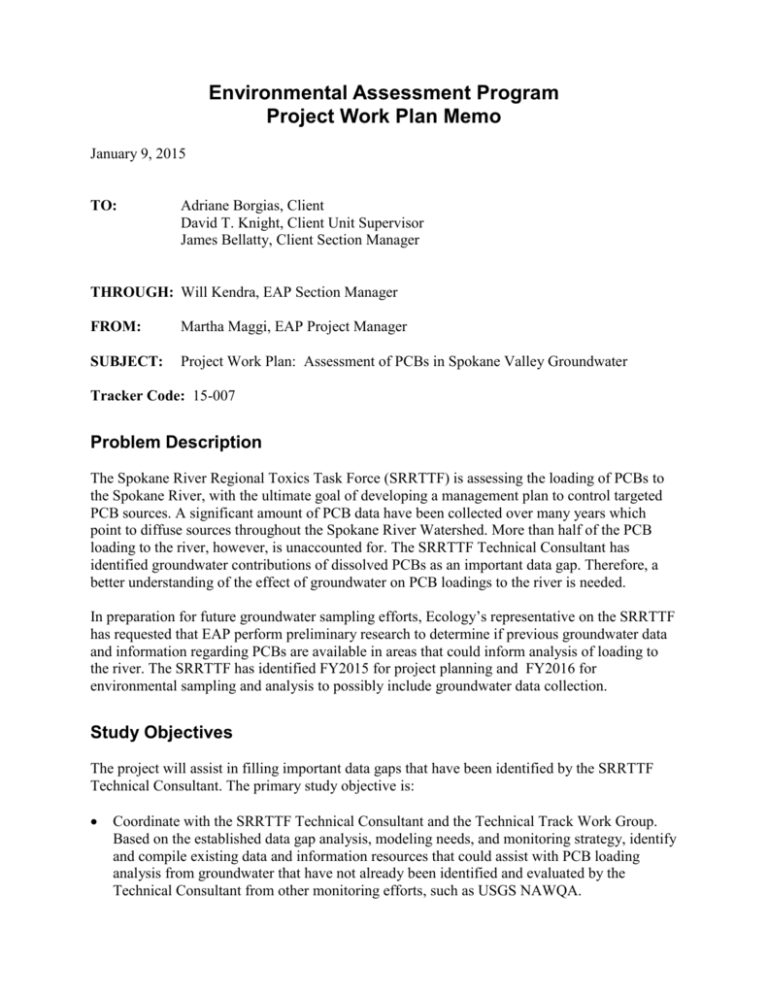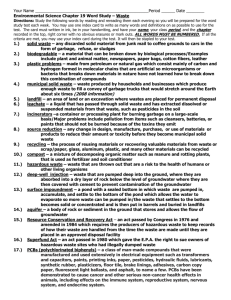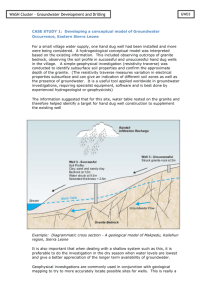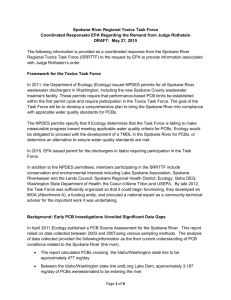PCBs in Spokane Valley Groundwater Project Work Plan memo 1
advertisement

Environmental Assessment Program Project Work Plan Memo January 9, 2015 TO: Adriane Borgias, Client David T. Knight, Client Unit Supervisor James Bellatty, Client Section Manager THROUGH: Will Kendra, EAP Section Manager FROM: Martha Maggi, EAP Project Manager SUBJECT: Project Work Plan: Assessment of PCBs in Spokane Valley Groundwater Tracker Code: 15-007 Problem Description The Spokane River Regional Toxics Task Force (SRRTTF) is assessing the loading of PCBs to the Spokane River, with the ultimate goal of developing a management plan to control targeted PCB sources. A significant amount of PCB data have been collected over many years which point to diffuse sources throughout the Spokane River Watershed. More than half of the PCB loading to the river, however, is unaccounted for. The SRRTTF Technical Consultant has identified groundwater contributions of dissolved PCBs as an important data gap. Therefore, a better understanding of the effect of groundwater on PCB loadings to the river is needed. In preparation for future groundwater sampling efforts, Ecology’s representative on the SRRTTF has requested that EAP perform preliminary research to determine if previous groundwater data and information regarding PCBs are available in areas that could inform analysis of loading to the river. The SRRTTF has identified FY2015 for project planning and FY2016 for environmental sampling and analysis to possibly include groundwater data collection. Study Objectives The project will assist in filling important data gaps that have been identified by the SRRTTF Technical Consultant. The primary study objective is: Coordinate with the SRRTTF Technical Consultant and the Technical Track Work Group. Based on the established data gap analysis, modeling needs, and monitoring strategy, identify and compile existing data and information resources that could assist with PCB loading analysis from groundwater that have not already been identified and evaluated by the Technical Consultant from other monitoring efforts, such as USGS NAWQA. Scope-of-Work and Tasks The SRRTF Technical Consultant has identified data gaps, developed a monitoring strategy, and written a draft QAPP for monitoring activities. The geographic scope of these activities includes the Spokane River upstream of Lake Spokane to the outlet of Lake Coeur d’Alene in Idaho. This current project will cover a similar geographic scope (RM111 to RM 58, the Nine-Mile dam) in order to be useful for future planning. The tasks will focus on−but not be limited to−areas identified by the Technical Consultant as needing further data or information. Tasks include: 1) Identify status of Toxics Cleanup Program (TCP) sites with PCBs that could be contributing to groundwater. Several cleanup areas and former cleanup areas could still have residual PCBs that are loading to groundwater. In this part of the analysis, we will develop a spreadsheet that identifies those sites and summarizes their characteristics such as: whether PCBs were identified proximity to river proximity to groundwater status of cleanup cleanup standards that were used presence of wells presence of PCBs in the groundwater (if known) data quality reported in EIM or in other documentation recommendations regarding future sampling We will interview TCP and our Urban Waters personnel, review documentation regarding the current status of the sites, and prepare a matrix. 2) Perform well log review. We will identify and review well logs in Ecology’s database for supply and monitoring wells (in addition to the TCP sites above) that might be appropriate for data mining or future monitoring. Criteria for inclusion will be developed in consultation with the TTWG, but will likely include the following: wells near identified PCB sources wells within ½ mile distance of the river wells adjacent to gaining reaches 3) Research PCB-laden supply well pumps. We will determine whether pre-1978 supply well pumps that were fabricated using PCB coolant oil might be in place in the Spokane River reaches of interest. We will contact Spokane Regional Health District for information. 4) Research Underground Injection Program (UIC) wells in the area. We will identify possible past PCB oil disposal areas such as dry wells located at industrial facilities which could be in hydraulic connection with groundwater. We will review UIC program-registered wells and consult with Spokane Regional Health District. A technical memorandum will be developed responding to these 4 areas of investigation. Schedule Product Progress Report – Task 1 Product lead Schedule Draft to client Martha Maggi January 9, 2014 Final Memo (will incorporate Task 1 progress report) Product lead Martha Maggi Schedule Draft due to supervisor March 31, 2015 Draft due to client April 17, 2015 Final memo April 30, 2015 cc: Carol Smith Melissa McCall (for Activity Tracker)









